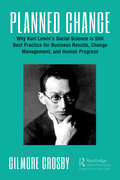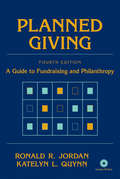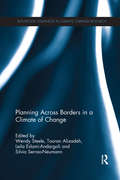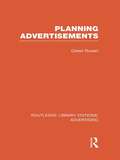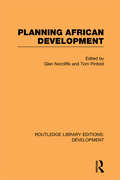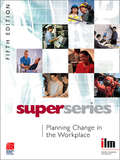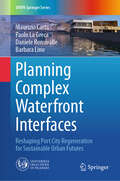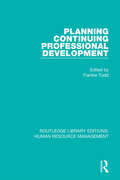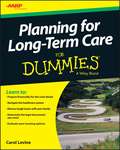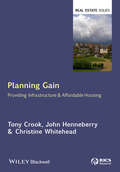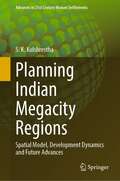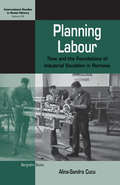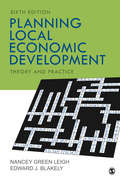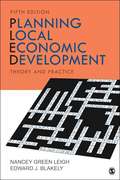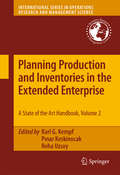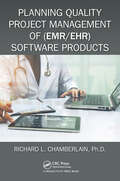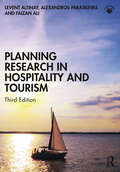- Table View
- List View
Planned Change: Why Kurt Lewin's Social Science is Still Best Practice for Business Results, Change Management, and Human Progress
by Gilmore Crosby"Gil Crosby has accomplished what most of us in the world of applied behavioral science, in general, and OD and T-Group training, in particular, have not—making the theoretical father of our work accessible. Thus, this book is a gift and with it we can understand more deeply and teach others more accurately what Lewin actually stated and meant. Moreover, the book is reader-friendly, visually appealing, and humorous rather than academically boring. Thank you, Gil!" Dr. W. Warner Burke E.L. Thorndike Professor of Psychology and Education Teachers College, Columbia University Kurt Lewin (1890-1947) was a visionary psychologist and social scientist who used rigorous research methods to establish an approach to planned change that is both practical and reliable. He mentored and inspired most of the early professionals who came to identify themselves as practitioners of organization development (OD). He also fostered the emergence of the experiential learning method known as the T-group, which uniquely structures group dynamics into a laboratory for dramatic individual and team development. In the early days, most OD professionals learned much about themselves and about group dynamics through T-group experiences. Lewin’s methods, though little known, yield consistent business results such as increased performance and improved morale. His approaches have the rare impact of not just changing behavior, but changing the beliefs that underlie behavior. Sadly, most OD professionals today— business and organizational leaders, community organizers, and people, in general—have never read any of Lewin’s actual writing beyond a quote or two. Indeed, some in the OD profession have rejected or distanced themselves from what they think Lewin taught, even though they and many others seem to know very little about his methods or history. Because Lewin was a prolific writer, one of the author’s main goals is to organize his immense body of published work so that readers can easily explore the source material and form their own opinions. Essentially, this book is aimed at introducing Lewin in a new way, both simplified yet substantial enough to guide anyone who is trying to plan change, whether at the individual, group/team, organizational, or societal levels. Lewin was not trying to create methods for OD professionals alone (or for social scientists as he regarded himself). In his interventions, he taught those how to do their own version of planned change. He believed social science might be the light that helps create a brighter future for humanity. This text transfers this knowledge to a broad audience so that each reader can more successfully implement organizational and social change.
Planned Giving
by Katelyn L. Quynn Ronald R. JordanCompletely revised and updated, the Fourth Edition of this popular resource recognizes the emerging importance of planned giving and the changes that have taken place over the last few years. The new edition now includes a convenient, easy-to-use CD-ROM filled with exhibits, documents, and forms. With a new focus on user-friendly content and helpful insights, tips, warnings, and perspectives, the new edition empowers fundraising professionals with the ability to speak the same language as donors and their advisors, while still keeping their own organization's goals in mind.Note: CD-ROM/DVD and other supplementary materials are not included as part of eBook file.
Planning Across Borders in a Climate of Change (Routledge Advances in Climate Change Research)
by Wendy Steele Silvia Serrao-Neumann Tooran Alizadeh Leila Eslami-AndargoliThe fixity or mobility of borders are key themes within the border studies literature and have useful critical application to urban and environmental planning through theory, pedagogy and practice. This offers potential for transformative change through the processes of re-bordering and re-orienting established boundary demarcations in ways that support and promote sustainability in a climate of change. Planning Across Borders in a Climate of Change draws on a range of diverse case studies from Australasia, North and South America, Europe, Africa, the Middle East and Asia and offers the application of border theory, concepts and principles to planning as a critical lens. It applies this lens to a range of international case studies in key areas such as climate change adaptation, food security, spatial planning, critical infrastructure and urban ecology. This collection fills an important gap in the border studies literature, bringing climate change considerations to bear on planning. It should be of interest to students, scholars and professionals in the field of urban and environmental planning, climate change adaptation, border studies, urban studies, human and political geography, environmental studies and development.
Planning Advertisements: Advertising: Planning Advertisements (Routledge Library Editions: Advertising)
by Gilbert RussellThe purpose of every advertisement is to sell the thing which it advertises. Looking at the full range of the planning involved in the advertising business, Planning Advertisements first considers the initial stage, where the advertisement practitioner—advertiser relationship is paramount, before looking at the planning stages needed for all types of advertising, ranging from direct mail to hoardings. First published in 1935.
Planning African Development (Routledge Library Editions: Development)
by Glen Norcliffe Tom PinfoldFirst published in 1981, this book concerns specifically the Kenyan experience with regards to development planning but, given that the problems of hunger poverty and underdevelopment manifest themselves in slightly different forms across all African countries, this book has considerable relevance to development planning across the African continent.The first set of essays in this collection address the question of development which is undoubtedly Africa’s highest development priority. The second grouping of essays considers issues in project planning and asks questions concerning cost, method, outcome and evaluation of various projects in Kenya
Planning Armageddon: British Economic Warfare and the First World War
by Nicholas A. LambertBefore the First World War, the British Admiralty conceived a plan to win rapid victory in the event of war with Germany-economic warfare on an unprecedented scale.This secret strategy called for the state to exploit Britain's effective monopolies in banking, communications, and shipping-the essential infrastructure underpinning global trade-to create a controlled implosion of the world economic system. In this revisionist account, Nicholas Lambert shows in lively detail how naval planners persuaded the British political leadership that systematic disruption of the global economy could bring about German military paralysis. After the outbreak of hostilities, the government shied away from full implementation upon realizing the extent of likely collateral damage-political, social, economic, and diplomatic-to both Britain and neutral countries. Woodrow Wilson in particular bristled at British restrictions on trade. A new, less disruptive approach to economic coercion was hastily improvised. The result was the blockade, ostensibly intended to starve Germany. It proved largely ineffective because of the massive political influence of economic interests on national ambitions and the continued interdependencies of all countries upon the smooth functioning of the global trading system. Lambert's interpretation entirely overturns the conventional understanding of British strategy in the early part of the First World War and underscores the importance in any analysis of strategic policy of understanding Clausewitz's "political conditions of war."
Planning Change in the Workplace (Institute of Learning & Management Super Series)
by Institute of Leadership & ManagementSuper series are a set of workbooks to accompany the flexible learning programme specifically designed and developed by the Institute of Leadership & Management (ILM) to support their Level 3 Certificate in First Line Management. The learning content is also closely aligned to the Level 3 S/NVQ in Management. The series consists of 35 workbooks. Each book will map on to a course unit (35 books/units).
Planning Complex Waterfront Interfaces: Reshaping Port City Regeneration for Sustainable Urban Futures (UNIPA Springer Series)
by Maurizio Carta Daniele Ronsivalle Paolo La Greca Barbara LinoThis book presents a comprehensive examination of the complex interactions between port systems and urban environments, with a particular focus on international methodologies and site-specific case studies from the waterfronts of Palermo and Catania and the West Sicily Sea Authority. It addresses the multifaceted challenges and opportunities inherent in waterfront regeneration, emphasizing the critical importance of developing new urban interfaces that seamlessly connect ports to their surrounding cities. These interfaces serve not only as physical transitions but also as vital cultural and economic linkages that foster community engagement and enhance the liveability of urban spaces. The work offers a series of detailed analyses that highlight the necessity of integrating heritage protection within contemporary urban planning frameworks. By exploring historical developments and current initiatives, it provides valuable insights applicable to diverse global contexts, making it relevant for policymakers, urban planners, and scholars dedicated to understanding the future of port cities. Through rigorous exploration of strategic planning and stakeholder engagement, this book highlights pathways toward innovative solutions that respect historical contexts while advancing sustainable urban futures. By prioritizing the creation of effective urban interfaces, it contributes to the broader discourse on port-city relationships worldwide, underscoring their significance in shaping resilient and vibrant urban environments.
Planning Continuing Professional Development (Routledge Library Editions: Human Resource Management Ser.)
by Frankie ToddContinuing professional development (CPD) aims to maintain or improve the quality of professional performance. So far, it tends to have been designed for specific professional groups such as teachers, doctors, architects or engineers. Approaches, as a result, have often been local, separatist or idiosyncratic in nature. This book, first published in 1987, argues that CPD designers should consider strategies used for professional groups other than their own. This title will be useful to anyone with a responsibility for developing and implementing courses and also to practitioners themselves, as well as to students of business studies.
Planning For Long-Term Care For Dummies
by LevineExpert advice on planning for your own or a relative's future care needsAs we live longer and healthier lives, planning for the long term has never been more important. Planning gives you more control, but it's not easy to find accurate information and answers to your questions. That's where AARP's Planning For Long-Term Care For Dummies comes in.This comprehensive guide gives you questions to ask yourself and others about how best to achieve your goals, whether you have immediate needs or can take some time to sort out the possibilities. The book Covers home modifications so that you can stay at home safely for as long as you likeLays out the opportunities and costs associated with independent living, assisted living, and other optionsGives you a range of driving and transportation alternativesSorts out the various sources of care at homeHelps you navigate the healthcare systemReviews the legal documents you should prepare and updateHelps you determine whether you need long-term care insuranceOffers checklists and other resources to help you make decisionsGives you guidance on how to talk to your family about sensitive issuesIf you're looking for trusted information on how to prepare for the future care needs for yourself or a relative, this sensitive, realistic, and authoritative guide will start you on the right road.
Planning Gain
by Christine Whitehead Tony Crook John HenneberryThis critical examination of the development and implementation of planning gain is timely given recent changes to the economic and policy environment. The book looks both at the British context as well as experience in other developed economies and takes stock of how the policy has evolved. It examines the rationale for planning gain, how it has delivered substantial funds for infrastructure and affordable housing and, in the light of this, how it might continue to play a role in the funding of these. It also draws on overseas experience, for example on impact fees and public sector land assembly. It looks at lessons from the past for future policy, both for Britain and for countries overseas. Mechanisms to tap development value are also a global phenomenon in developed market economies - whether through formal taxation or negotiated contributions. As fiscal austerity becomes an increasingly challenging issue, 'planning gain' has grown in importance as a potential source of funding for infrastructure and new affordable housing, with many countries keen to examine, learn from, and adapt the experience of others. a critical commentary of planning gain as a policy timely post credit crunch analysis addresses recent planning policy changes
Planning Indian Megacity Regions: Spatial Model, Development Dynamics and Future Advances (Advances in 21st Century Human Settlements)
by S. K. KulshresthaThis book focuses on spatial planning of megacities that are growing in Asia, Africa, and America. These cities are not be seen in isolation from their respective influence regions. They complement each other. Most of the solutions to the problems of such cities are found in their respective regions, and, on the other hand, the regions derive their strength from their respective megacities. There is a need for promoting integrated spatial planning of megacity regions. The five chapters in this book highlight the spatial planning of such regions.
Planning Labour: Time and the Foundations of Industrial Socialism in Romania (International Studies in Social History #32)
by Alina-Sandra CucuImpoverished, indebted, and underdeveloped at the close of World War II, Romania underwent dramatic changes as part of its transition to a centrally planned economy. As with the Soviet experience, it pursued a policy of “primitive socialist accumulation” whereby the state appropriated agricultural surplus and restricted workers’ consumption in support of industrial growth. Focusing on the daily operations of planning in the ethnically mixed city of Cluj from 1945 to 1955, this book argues that socialist accumulation was deeply contradictory: it not only inherited some of the classical tensions of capital accumulation, but also generated its own, which derived from the multivocal nature of the state socialist worker as a creator of value, as living labour, and as a subject of emancipatory politics.
Planning Local Economic Development: Theory and Practice
by Nancey G. Leigh Dr Edward J. BlakelyWritten by authors with years of academic, regional, and city planning experience, the classic Planning Local Economic Development has laid the foundation for practitioners and academics working in planning and policy development for generations. With deeper coverage of sustainability and resiliency, the new Sixth Edition explores the theories of local economic development while addressing the issues and opportunities faced by cities, towns, and local entities in crafting their economic destinies within the global economy. Nancey Green Leigh and Edward J. Blakely provide a thoroughly up-to-date exploration of planning processes, analytical techniques and data, and locality, business, and human resource development, as well as advanced technology and sustainable economic development strategies.
Planning Local Economic Development: Theory and Practice
by Nancey G. Leigh Dr Edward J. BlakelyWritten by authors with years of academic, regional, and city planning experience, the classic Planning Local Economic Development has laid the foundation for practitioners and academics working in planning and policy development for generations. With deeper coverage of sustainability and resiliency, the new Sixth Edition explores the theories of local economic development while addressing the issues and opportunities faced by cities, towns, and local entities in crafting their economic destinies within the global economy. Nancey Green Leigh and Edward J. Blakely provide a thoroughly up-to-date exploration of planning processes, analytical techniques and data, and locality, business, and human resource development, as well as advanced technology and sustainable economic development strategies.
Planning Local Economic Development: Theory and Practice
by Nancey G. LeighAuthor Nancey Green Leigh brings years of academic and professional experience to this classic text, which offers a comprehensive look at the basic tenets of local economic development planning. The book explores the theories of local economic development while addressing the issues and opportunities faced by cities, towns, and local entities in crafting their economic destinies within the global economy. The new Seventh Edition is updated with an increased focus on sustainability and equity, including local economic development issues arising from the global COVID-19 pandemic and significant shifts in the global economy.
Planning Local Economic Development: Theory and Practice
by Nancey G. LeighAuthor Nancey Green Leigh brings years of academic and professional experience to this classic text, which offers a comprehensive look at the basic tenets of local economic development planning. The book explores the theories of local economic development while addressing the issues and opportunities faced by cities, towns, and local entities in crafting their economic destinies within the global economy. The new Seventh Edition is updated with an increased focus on sustainability and equity, including local economic development issues arising from the global COVID-19 pandemic and significant shifts in the global economy.
Planning Local Economic Development: Theory and Practice 5th Edition
by Edward J. Blakely Nancey Green LeighSince the appearance of the first edition in 1990, Planning Local Economic Development has been the foundation for an entire generation of practitioners and academics working in planning and policy development. Written by authors with years of academic, regional, and city planning experience, the book has been used widely in graduate economic development, urban studies, nonprofit management, and public administration courses. Now thoroughly updated for the challenges of the 21st century with deeper coverage of sustainability and resiliency, the Fifth Edition explores the theories of local economic development while addressing the issues and opportunities faced by cities, towns, and local entities in crafting their economic destinies within the global economy. Authors Nancey Green Leigh and Edward J. Blakely provide a thoroughly up-to-date exploration of planning processes, analytical techniques and data, and locality, business, and human resource development, as well as advanced technology and sustainable economic development strategies. New to the Fifth Edition: Addresses the challenges to local economic development planning posed by the weak recovery to the Great Recession Introduces social network analysis Covers the importance of urban design for local economic development success and the potential of LEED neighborhood design Expands the focus on public-private partnerships and community marketing for implementing economic development plans Offers new case studies and illustrations
Planning Production and Inventories in the Extended Enterprise: A State of the Art Handbook, Volume 1 (International Series in Operations Research & Management Science #151)
by Karl G. Kempf Pınar Keskinocak Reha UzsoyIn two volumes, Planning Production and Inventories in the Extended Enterprise: A State of the Art Handbook examines production planning across the extended enterprise against a backdrop of important gaps between theory and practice. The early chapters describe the multifaceted nature of production planning problems and reveal many of the core complexities. The middle chapters describe recent research on theoretical techniques to manage these complexities. Accounts of production planning system currently in use in various industries are included in the later chapters. Throughout the two volumes there are suggestions on promising directions for future work focused on closing the gaps.
Planning Production and Inventories in the Extended Enterprise: A State-of-the-Art Handbook, Volume 2
by Pınar Keskinocak Reha Uzsoy Karl G KempfIn two volumes, Planning Production and Inventories in the Extended Enterprise: A State of the Art Handbook examines production planning across the extended enterprise against a backdrop of important gaps between theory and practice. The early chapters describe the multifaceted nature of production planning problems and reveal many of the core complexities. The middle chapters describe recent research on theoretical techniques to manage these complexities. Accounts of production planning system currently in use in various industries are included in the later chapters. Throughout the two volumes there are suggestions on promising directions for future work focused on closing the gaps. Included in Volume 1 are papers on the Historical Foundations of Manufacturing Planning and Control; Advanced Planning and Scheduling Systems; Sustainable Product Development and Manufacturing; Uncertainty and Production Planning; Demand Forecasting; Production Capacity; Data in Production and Supply Chain Planning; Financial Uncertainty in SC Models; Field Based Research in Production Control; Collaborative SCM; Sequencing and Coordination in Outsourcing and Subcontracting Operations; Inventory Management; Pricing, Variety and Inventory Decisions for Substitutable Items; Perishable and Aging Inventories; Optimization Models of Production Planning Problems; Aggregate Modeling of Manufacturing Systems; Robust Stability Analysis of Decentralized Supply Chains; Simulation in Production Planning; and Simulation-Optimization in Support of Tactical and Strategic Enterprise Decisions. Included in Volume 2 are papers on Workload and Lead-Time Considerations under Uncertainty; Production Planning and Scheduling; Production Planning Effects on Dynamic Behavior of A Simple Supply Chain; Supply and Demand in Assemble-to-Order Supply Chains; Quantitative Risk Assessment in Supply Chains; A Practical Multi-Echelon Inventory Model with Semiconductor Application; Supplier Managed Inventory for Custom Items with Long Lead Times; Decentralized Supply Chain Formation; A Cooperative Game Approach to Procurement Network Formation; Flexible SC Contracts with Options; Build-to-Order Meets Global Sourcing for the Auto Industry; Practical Modeling in Automotive Production; Discrete Event Simulation Models; Diagnosing and Tuning a Statistical Forecasting System; Enterprise-Wide SC Planning in Semiconductor and Package Operations; Production Planning in Plastics; SC Execution Using Predictive Control; Production Scheduling in The Pharmaceutical Industry; Computerized Scheduling for Continuous Casting in Steelmaking; and Multi-Model Production Planning and Scheduling in an Industrial Environment.
Planning Quality Project Management of (HIMSS Book Series)
by Richard ChamberlainWhen hospitals began implementing their electronic medical records/electronic health records systems (EMR/HER) the pharmaceutical companies that were conducting clinical trials at those hospitals wanted to sue the date from those systems instead of having the hospitals enter the data in their EHR systems and also in the study data entry system. However, the FDA regulations would require that the hospital systems be "validated". The hospitals and the companies developing the systems argued that was "over-regulation." HIMSS published their Developer Code of Conduct where they said instead they would use Quality Management techniques. This book covers how to use Quality Management (ISO 9001) to develop computer systems, specifically EMR systems. It gives a basic introduction to how to implement computer systems. It also covers the topic of compliance because the hospitals are required to comply with regulations other than FDS regulations. The book also discusses the topics of risk management and conducting audits, both of which are part of ISO 9001 quality management of computer systems. The book is designed to give the reader an introduction to the things you have to do when implementing a computer system that has to satisfy some standards and where the accuracy of the information could impact the accuracy of a person’s medical treatment.
Planning Research in Hospitality & Tourism
by Levent Altinay Alexandros ParaskevasPlanning Research in Hospitality and Tourism provides a concise and clear approach to planning research projects which are a necessity in most hospitality and tourism courses taught at degree level. The text considers the particular characteristics of the hospitality and tourism industry, whilst providing a balanced approach toward both quantitative and qualitative methods of research. The text also carefully considers the international aspect of the industry and the people it employees, which supports the books aims of:* Providing an excellent understanding of the basic principles of conducting research, in a straight forward “no nonsense” guide* Carefully considering the particular characteristics of the hospitality and tourism sectors in relation to embarking on a research project in the area* Including in each chapter an “International Dimension” section, as well as case studies, questions and reflections on the research process
Planning Research in Hospitality and Tourism
by Levent Altinay Soocheong Shawn Jang Alexandros ParaskevasPlanning Research in Hospitality and Tourism provides an accessible, concise and practical guide to planning, conducting and analysing research in tourism and hospitality. The authors skilfully introduce the basic principles and techniques of research in the international hospitality and tourism sectors, and provide detailed guidance on both quantitative and qualitative methods of research. It includes a variety of features throughout to aid students' understanding and offers practical tips to help students overcome any potential research issues. Building on the success of the first edition, the volume has been fully revised and updated, and contains new chapters on mixed methods and how to make best use of recent technology in research practices. The second edition also benefits from: * increased coverage of research design strategies including sampling, ethnography and experimental design * inclusion of computer-mediated data collection techniques, such as online interviews, online focus groups and online observation (netnographic research) * new and updated international case studies and extracts, with a more even spread of tourism and hospitality examples of research * online student and lecturer resources, including PowerPoint slides and a test bank of multiple choice and true/false questions for each chapter. Written by three leading scholars with experience of both the industry and university courses globally, this insightful text is an essential resource for all tourism and hospitality research students and early career research professionals around the world.
Planning Research in Hospitality and Tourism
by Levent Altinay Alexandros Paraskevas Faizan AliPlanning Research in Hospitality and Tourism, third edition is an accessible, concise and practical guide to planning, conducting and analysing research in tourism and hospitality.International in scope and appeal, this book provides students with an introduction to the basic principles, research techniques and characteristics of research in the international hospitality and tourism sectors in a straightforward and accessible way. It includes a variety of features throughout to aid understanding and offer practical tips of overcoming potential research issues.This new edition has been fully updated to include: New chapters on mixed methods and how to adopt technology into research practices More coverage of research strategies, focus groups, sampling secondary research as well as experimental design New and updated international case studies and extracts from journals, providing real examples of tourism and hospitality research scenarios Student and lecturer online resources, including practice datasets for students Enriched with insightful case studies throughout, this volume is essential reading for all tourism and hospitality researchers.
Planning Successful Meetings and Events: A Take-Charge Assistant Book (The\take Charge Assistant Ser.)
by Ann J. BoehmePlanning a meeting or event is no easy task. Just ask any of the administrative staffers who are increasingly being asked to do it. One minor mistake -- a plane ticket that doesn't arrive on time, not enough vegetarian meals at the luncheon, the wrong kind of audio/visual equipment -- can mean big trouble.Now this handy little how-to guide takes secretaries and assistants through the entire process step-by-step. From site selection and registration do's and don'ts to negotiating with vendors and food and beverage planning, this book gives them everything they need to get a meeting planned right.Packed with floor plans, checklists, glossaries of industry-specific terms, lists of resources, and more, Planning Successful Meetings and Events is sure to transform any take-charge assistant into the Martha Stewart of meeting and event planning. It's a good thing.
